
Hi Gang…
From time to time, you read articles here at Forgotten Fiberglass that in some way involve recognition of the Art Center in Los Angeles, California. This is an important reference for me and recognition on our behalf that many of the designers of the fiberglass sports cars that we’ve come to love, attended and graduated from the Art Center. Other folks even went on to be instructors.
For example, Hugh Jorgensen and Merrill Powell from Victress were students – so was Mel Keys. Chuck Pelly, who built the famous BMW design house was an Art Center student who worked with Victress. Bill Tritt of Glasspar was an invited speaker there more than once. Jim Webb who designed and built the Savage, and many of the folks who worked for and with these same companies and people were Art Center students as well – Hugh Nutting and Jim Valentine come to mind.
Others include Bob Gurr who designed the Autopia cars for Disney and was a student there (Autopia cars were built by Glasspar and assembled by Mameco). And of course, the designer of the LeMans Coupe, Strother MacMinn, was one of the best noted individuals from that time frame.
There’s no shortage of talent produced from this center of automotive design creativity, and we count many of those who are currently there part of our group too – including current Chairman of Transportation Design at the Art Center, Steward Reed – who also worked with Bruce Meyers and designed the SR sports car for Bruce and his company back in the early 1970s.
Creativity and design innovation abound at this school – both in the past and today.
Based on the observations above, I thought it appropriate to share this article from Road & Track that was published in September 1955. What’s interesting is that by this date – 1955 – the Art Center was 25 years old. Now it’s over 80 years old and growing strong.
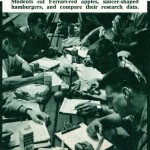
Caption: Students Eat Ferrari-Red Apples, Saucer-Shaped Hamburgers, and Compare Their Research Data.
Today’s article is dedicated to the Art Center and the students who attended – what a great impact you and your school have made to the automobile industry – and the more I learn of the school and their students – the more impressed I get each and every day.
Let’s have at it gang. Here’s the article for your review:
Art Center: 5353 West Third Street, Los Angeles, California
Industrial Design….Automotive Division
Road & Track: September 1955
A few months ago some fifty top designers got together for a back-slapping good time in Detroit, the city of their adoption, because the avenue of their professional adventures was unanimous. Although many of the group had only been there three or four years, a number of those present were Executives supervising key departments.
All of them were Art Center graduates, and their spontaneous esprit de corps was typical of the atmosphere which stimulated their education. Historically speaking, the school was founded twenty-five years ago by Edward A. Adams, an advertising executive who was interested in closing the gap between the point where most training institutes left off, and where professional practice began.
He started by establishing a nucleus of instructors who were practicing professionals so that all contacts with industry were constantly up-to-date, and has maintained this policy ever since. A perfect example of this policy is exemplified by Mr. George Jergenson, Head of the Industrial Design Department.
He was with the General Motors Styling Section for eleven years (Buick, Chevrolet, Export, and Cadillac studios), climaxed as Director of the GM Industrial Design Studio. Mr. Jergenson left GM to go to the Art Center Industrial Department, and continues to work as a free-lance Industrial Designer in his spare time.
The school has been accepted by all veteran’s training programs, and is also accredited by the Western Colleges Association, being the first independent Art School to receive such an honor. In addition to the basic program of instruction, a Baccalaureate Degree (Bachelor of Professional Arts) is available to students who complete a minimum of 120 semester units; 20 units devoted to general studies – such as Social Science, Humanities, History, Math, etc.; at least 40 semester units taken in the department in which the student majors; complies with a specified grade average; and maintains a satisfactory record of attendance and deportment.
The school is divided into five major departments: Advertising Design, Painting, Illustration, Photography, and Industrial Design, with all units stressing professional application as the ultimate aim. These departments are in turn broken down into various specialized fields of endeavor. The Industrial Design Department in itself offers Majors in: Product Design, Specialized Structural Design, Packaging and Display, and Transportation.
No student is allowed to get into “Ivory Towers” about design approach. He is trained to combine his imaginative design with technical proficiency. He must understand form, know color and materials, be able to render and draft, and be able to meet and collaborate with engineers.
No automobile design is started without first covering all the aspects of how people are related to the product – from the ones that make them, sell them, buy them, ride in them, and what the buyer plans to do with them. Every semester ten top students are selected from the third and fourth semester levels in the transportation group, to spend a semester working in the Advanced Styling Section of a major automobile manufacturer.
This on-the-job training gives the students a first hand sample of the work they will be doing later. When they return to complete their education they have their objective more concretely established in their minds. This training also tends to pull the student down out of the clouds to face a challenge which confronts every designer. How can he satisfy his ultimate aim as a designer and simultaneously produce ideas which reflect the character and individuality of each manufacturer.
Exploration is constantly toward new and different ideas which will refresh and stimulate the buyer, and at the same time be compatible with manufacturing methods and costs. Another main point of the Art Center curriculum is that super-specialization is seldom the key to success. Hence every opportunity is taken to broaden the students’ scope by not only encouraging general studies in the degree program, but also selecting elective courses in indirect subjects which can complement their chosen field.
A sample Major in Transportation would include the following subjects: Perspective, technical drawing, design, industrial color, psychology of color, industrial drawing, American history, American Institutions, architectural drafting, graphic design, general studies, product design, specialized structures, transportation, materials and methods, model constructions, and special projects.
Electives include: products design, lettering, packaging and display, industrial rendering, sketching for illustration, contemporary furniture, specialized structures, figure design, and numerous other related subjects. To further Mr. Adam’s original idea of bridging the gap between schooling and industry, the school schedules are planned to keep the student under pressure, confronting him with working conditions and problems which simulate those in the industry.
Class assignments are given in advance along with a deadline date which must be met. Going on the assumption that a student failing to meet school schedules will probably fail to meet commercial deadlines, he is subject to immediate dismissal – matching punishment dealt by the commercial world – fired!
It is the purpose of the Art Center School to train talented me and women for thorough professional careers as artists in business and industry. A young designer, properly trained in a professional school, by professionals – men and women who practice daily what they preach – finds a willing and active Industry awaiting him.
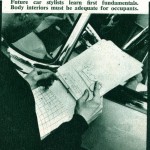
Caption: Future Car Stylists Learn First Fundamentals. Body Interiors Must Be Adepquate For Occupants.
Summary:
I will continue featuring articles about the Art Center of Los Angeles, and other schools of design on our website. It’s these very schools that brought the dreams of car design to life for so many young adults out there – many of which are still having the same impact today – that they did back then.
Hope you enjoyed the story, and until next time…
Glass on gang…
Geoff
——————————————————————-
Click on the Images Below to View Larger Pictures
——————————————————————-
- Caption: An Exchange of Ideas With Instructor Strother MacMinn (at far right.)
- Caption: Students Eat Ferrari-Red Apples, Saucer-Shaped Hamburgers, and Compare Their Research Data.
- Caption: Clay Modelling Classes Are Supervised By Veteran Automotive Craftsman, Mr. Joe Thompson.
- Caption: Future Car Stylists Learn First Fundamentals. Body Interiors Must Be Adepquate For Occupants.
- Caption: Design Renderings That Are Completely Uninhibited Are Encouraged.
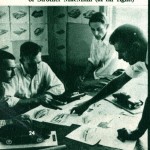
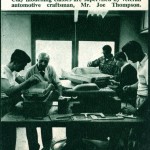
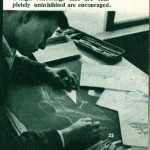

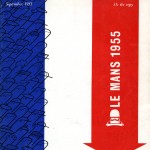
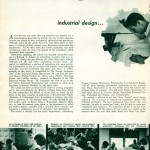
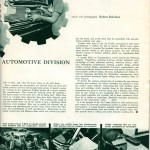
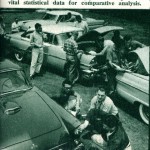

Thanks for the mention Geoff.I remember those days very well,best time of my life..I swear thats me in the middle on the right side of the picture eating those Ferrari apples..Great story.
Mel